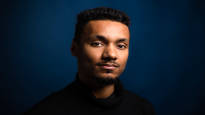When we see a picture of the plight of Ukrainians, we see ourselves in them. But when we witness the plight of the Palestinians, we also see something we have learned, Iduozee writes.
Uwa Iduozee photographer and documentarian
They could be our children!
The statement has been etched in my mind since the early months of the war in Ukraine. Shocking images of civilians killed in Russian bombings, especially children, reminded Finns of the fragility of life. The images forced one to confront the threat and absurdity of war in a way that most Europeans haven’t had to do in generations.
It matters whose suffering it is.
The impact of the imagery was palpable. The Finns, like many others, activated themselves to help in an unprecedented way. Some even were driving itself to the Ukrainian border to deliver supplies that the locals desperately need.
We interpret the imagery of suffering through identity. It means that it matters whose suffering it is – and who causes it.
Witnessing the plight of Ukrainians evoked unprecedented empathy. BBC reporter Peter Dobbie crystallized reaction on a live news broadcast to the bare words: “These are not refugees fleeing the Middle East… or North Africa. They look the same as any European family living next door.”
By showing the children’s suffering, the Palestinians hope that we outsiders will step up to help them.
Well now the bombs are falling Even in the Middle East – on the neck of the Palestinians, again. In the struggle for the empathy of the Western public, the Palestinians of Gaza have opened up a view of their everyday life by sharing images of children killed and injured in Israeli bombings. The Palestinians hope that by showing the children’s suffering, we outsiders would activate their help.
But as said, it does matter whose suffering we watch.
Palestinian children are not like us. At least not in the eyes of the public whose attention the pictures are aiming for. Namely, it is the public whose governments fund the bombing of Gaza, whose media understands the bombing, and who have more or less stood by as the Palestinians have been deprived rights, lands, history and life.
It is difficult to fit a messy picture with our need to create a basic black and white narrative of good and bad.
Palestinian civilians also live in the middle of the bombings are placed in our collective imagination in a frame of reference defined for decades by the Middle East image of terrorism and endless wars without reason or reason.
The picture is messy. In it, the Palestinians are both outsiders fighting against Western democracy and civilian victims of wars. It is difficult to fit a messy picture with our need to create a basic black and white narrative of good and bad.
Still sharing pictures of dead children is the cry of the Palestinians. The “women and children” suffix is proof of the innocence of the victims labeled as guilty. It’s a suffix meant to remind viewers of the images of our shared humanity.
To refer to Hamas every time we are asked to care about the lives of Palestinian civilians is cold and lazy.
At the same time, Palestinian men are deprived of the right to mourn. The public, who is asked to lend a hand through images of suffering, has been so thoroughly conditioned to see Muslim men as terrorists that if Palestinians ask us to mourn their fathers, uncles and brothers, we answer: “But Hamas.”
The attacks on civilians by Hamas must be condemned, unconditionally – not half a word about it. But to refer to Hamas every time we are asked to care about the lives of Palestinian civilians is cold and lazy. By ignoring the causes and context of the conflict, we justify all the other times we have turned a blind eye to the slow erasure of the Palestinians.
And it’s even more chilling, that at the same time we quietly convince ourselves that the Palestinians themselves are to blame for their suffering. This way we can maintain our sense of moral superiority even when we vote clear UN of the resolutionwhich calls for the protection of civilians caught by bombs.
Writer, poet and trauma psychologist Hug Alya writes the New York Times in his essaythat every time Palestinians share a photo of their dead children, they ask themselves, “Is this the photo that will finally do it?”
For our part, we have to ask ourselves how many more pictures of a dead Palestinian child do we need before we can say: could their children be our children?
Uwa Iduozee
The author is a documentarian and a former child.
